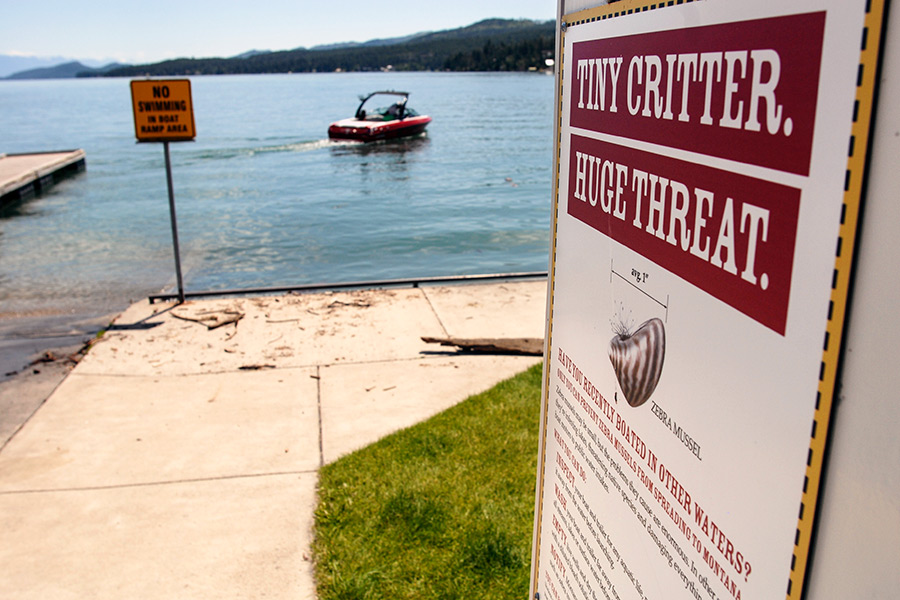Addressing budget-wary lawmakers on Feb. 14, agency officials charged with developing a long-term response to combat invasive species requested $11.5 million in additional funding from the Montana Legislature over the next two years and laid out plans to generate the revenue.
At a hearing before the Joint Appropriations Subcommittee on Natural Resources and Transportation, the heads of Montana Fish, Wildlife and Parks and the Department of Natural Resources and Conservation gave presentations detailing their coordinated plan and its attendant costs, which are substantially higher than the state’s current $1 million annual aquatic invasive species budget.
The committee, chaired by Carl Glimm, R-Kila, is scheduled to take final action on the department’s budget Friday.
State officials are responding to the first detection of aquatic invasive mussels in Montana after larvae were discovered last fall in water samples. Further testing confirmed the presence in Tiber Reservoir. Ongoing sampling and testing efforts turned up suspect water samples in Canyon Ferry Reservoir, the Missouri River below Toston Dam, and the Milk River.
The miniscule mussels, which cling to boats and other watercraft and can colonize rapidly, pose a dire threat and could present calamitous ecological and economic consequences.
The funding would ramp up the state’s boat-inspection, decontamination and sampling programs, while expanding educational outreach efforts and adding restrictions on boats in Montana waters.
Martha Williams, the newly minted FWP director, told the subcommittee that, although she has only been in charge of the state wildlife department for several weeks, the issue is a central concern.
“While I have not been at the helm of Fish, Wildlife and Parks for very long one thing has become crystal clear and that’s how important it is for Montana to add the serious issue of invasive mussels,” she said. “In order to succeed the state of Montana’s response requires a morphing of the existing aquatic invasive species program. It’s a heavy lift. We are all in with all hands on deck.”
The agency has created a bureau specifically to address the threat and is seeking to add 14 full-time employees to its team of 6.5 full-time aquatic invasive species employees. Williams said one-third of the agency would be charged with focusing on the issue this summer.
While the threat of invasive mussels has risen to the fore of public concern since the positive detections last fall, the budgetary request is a tough ask in a session committed to cutting the state’s budget, Glimm said.
The request amounts to $5.9 million for fiscal year 2018 and $5.5 million in 2019. An additional $2.3 million is being requested for seasonal staff to hit the ground running in 2017. Much of the $2.3 million would come from leftover federal and state funds.
Meanwhile the Department of Natural Resources and Conservation has been tasked by Gov. Steve Bullock to drum up additional sources of revenue.
John Tubbs, director of DNRC, said he is working on legislation to implement a boat sticker for resident and non-resident watercraft that would add approximately $4.1 million over the biennium, with residents paying $25 per year and non-residents $50.
Meanwhile, he said state officials are working on a proposal to establish a fee on hydropower facilities that could generate between $4 million and $6 million.
“Hydropower has to be part of the solution,” Tubbs said.
Dam operators could face exorbitant costs if mussels took root, clogging intake pipes and destroying infrastructure.
A revenue-generating bill is in draft form but has a sponsor, Tubbs said.
The agency is also seeking out grant money, which could be a major windfall to the tune of $9 million.
Noting that no technology exists to erase the presence of invasive mussels once they arrive, and conceding that a program that guarantees 100 percent reduced risk is likely impossible, Tubbs stressed the importance of acting with a heavy hand.
“We are going to be in this battle, and it may not be 100 percent successful, for quite some time. Well beyond this director’s tenure I suspect,” he said.
Williams, whose agency will ultimately oversee the invasive species program, told members of the subcommittee that “we need to throw the kitchen sink at it and I am ready to take that responsibility on.”
“I understand that our credibility is on the line,” Williams said. “I commit to the difficult work and the challenge we face as an agency.”
